
One of the most important things when it comes to Bitcoin and scalability is the “Scalability Trilemma.” This refers to the most suitable strategy or better to say the best balance between scalability, security, and decentralization. Usually, this issue relates to each type of cryptocurrency because, necessarily, the increase in efficiency in one of the three would produce as tradeoff an effect on the other two. For instance, a protocol with a faster consensus model would enhance scalability at the expense of security or decentralization.
Due to the Bitcoin POW consensus, security and centralization seem to be covered. However, the latter is becoming an issue, especially with the Lighting Network. Segwit was the reason that caused the hard fork with Bitcoin Cash, but to be able to aboard this concisely, let’s leave it on the side for now.

From the other side, the ability to scale is the most pressure matter that has been facing bitcoin for a while. For scalability, we intent the ability for the network to grow without impacting the speed of the transactions.
Because the miners need to approve the transactions in the block and each block is 1 MB of data, each block should take 10 minutes to get approved. Although in a period of massive queues it takes longer, Bitcoin now has an average of 4 to 7 transactions per second against 1,700 of Visa. In order to solve this issue, we are going to discuss two of the most known approaches.
The first one is Segwit, which is a soft fork of Bitcoin that allowed a change in the block structure to solve the transaction malleability problem. We know that the block is formed by data of the receiver output, the digital signature, and the sender output. The way the digital signature is written with the Legacy block allows a malicious actor to change the transaction id.
The information of the witness data, which is encrypted, is called “transaction ID,” and it can be changed maliciously without changing the transaction. Simply because the digital signature can be modified in a way that the mathematical computational check its still valid according to the network even though the hash will be different.
In this way, in the Legacy block (the block prior to the Segwit change), transaction ID can be changed and causes what is called the malleability issue.
This creates many problems, firstly because it can be exploited by people to cheat others that don’t wait for the confirmation of the block. Secondly, without such significant change, the lightning network could have never been developed. The reason why Segwit was implemented without a hard fork was to change the structure of the block. Contrary to popular opinion, Segwit is an increase in block size but in a different way than it was done with the hard fork of Bitcoin Cash.
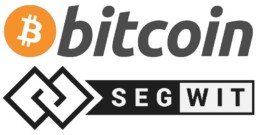
What Segwit did was to move in the signature data from outside the base box. They added an extended block in which the digital signature was included but is not part of the base block. This created two main advantages: by not being anymore part of the base box, the transaction ID would not be affected even if the digital signature is modified. And also, it has increased the available space for the witness data, so the block now has 4 MB in total, and therefore can contain more information.
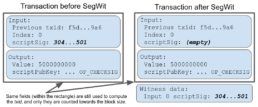
So the main pros are first the elimination of the malleability issue. And that it shrinks the base box leaving more space for data to fit in the block, therefore increasing the speed of the transactions in the network. I would probably add that transactions now could be cheaper.
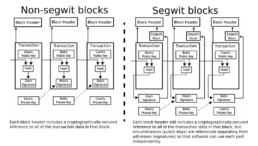
Thanks to this system, the Lightning Network was able to be implemented. Indeed because the second layer (Lightning Network) relies on the first layer (Bitcoin’s blockchain), then if the malleability issue was not solved, it directly couldn’t work.
It is essential to mention that we could not have increased the block size because, according to Bitcoin’s protocol, it would need to be 1 MB. So, developers had to find a solution to accept Segwit without a hard fork (as Bitcoin Cash did) to make sure that both blocks were allowed while the network was updated.
Again, another advantage of creating faster transactions is that Segwit would see the operation as a weight. What I mean by that is that miners would perceive Legacy’s block as size and Segwit’s block as what is in the witness data compared to its base. Because of the extended block, so miners can select lighter blocks to make faster transactions, and this would also reduce the fee.
Of course, this reduced fee is seen as a con for the miner because profitability could decrease. As a matter of fact, not many miners were happy with Segwit’s solution. The work of the miners can be affected in other ways, especially for mining pools. All of this has created a big debate in the bitcoin community.

Anyways, Segwit does not entirely solve the scalability issue. It just improves it a bit. Scalability is a problem that would always remain and would eventually be tied to milestones. At every stage of Bitcoin’s adoption and usage, new scalability concerns will arise.
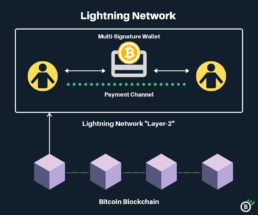
The second method to solve the scalability issue is the Lightning Network or LN. This is an open protocol built on top of Bitcoin’s network, and its central idea is that small transactions don’t have to be recorded directly on the blockchain but rather off-chain on a second layer.
LN is a way to create payment channels among two or more people to do multiple transactions and keep a ledger between them. Then, once reached the desired number of operations, report on the main blockchain only the final balance.

In this case, once the payment channel is opened, both users will choose the initial amount, which will be the maximum amount they can use in the circuit. The transactions will be signed in an off-chain and then reported on the blockchain only when the involved parties confirm it.
The LN has a sort of fraud mechanism in case one of the users tries to cheat the system. The deposit will be used to punish the cheater and sent it to the other party. The beauty of the system relies on its interconnect ability. If you don’t have to have a direct payment channel with somebody, you still can use the power of the network to reach that person through a preferred payment rout.
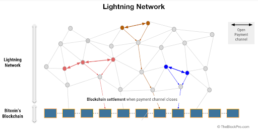
The payment channels work like an IOU sort of agreement, and when the channel is closed, the IOU is redeemed. Direct Channels would be free from fees, and fees would be paid only when the ledger would be brought back on the chain to settle the balance. This allows much faster speed on the transactions within the payment channel and frees up a lot of space on the blockchain, which will be used theoretically only for more critical payments.
It appears evident as Pro that speed is the first the most important of all. Even minimal payment can be made, and fees and transaction fees will be much cheaper. The transactions are secured and encrypted, and therefore This adds an extra layer of security to transactions made on the LN
The main Cons are very debatable but mostly reside in the fact that because you have to preload the channel with the upper spending of the Bitcoin, you would use instead user route in which you know you have enough BTC. Therefore this makes a debate on centralization of the network from a big institution or even banks that want to provide liquidity to the system. I would probably also argue since all the nodes are hot wallets that security could be in the same case an issue, and nodes could be targeted by hackers and malicious players.
About Antonio Velardo
Antonio Velardo is an experienced Italian Venture Capitalist and options trader. He is an early Bitcoin and Ethereum adopter and evangelist who has grown his passion and knowledge after pursuing the Blockchain Strategy Programme at Oxford University and a Master’s degree in Digital Currency at Nicosia University.
Antonio manages an 8-figure portfolio of his investment company with a team of analysts; he is a sort of FinTweet mentor, people interact with him online, and he has more than 40,000 followers after his tweets. He has built a fortune in the great tech years and put together a tail strategy during the pandemic that allowed him to take advantage of the market drop. “I did not time the market, and I did not think this was even a black sworn,” he says.
On the side of the financial markets, Velardo has a unique combination. He was a real estate entrepreneur that developed several projects in Tunisia, Miami, Italy, the UK, and many other countries and cities. But he has always been passionate about options trading. Still, contrary to the volatility player and quant trading, he always had a value investing touch in his blood. Antonio studied Value Investing at Buffet’s famous business school at Columbia University. Even though the central concepts of value investing are antagonists to the venture capital pillars, Antonio’s approach tries to bridge elements of both worlds in order to seek alpha. Velardo has learned the importance of spotting pure growth stories and taking advantage of their S-Curve position. This is an essential element of Velardo’s approach as he looks forward to embracing great tech stories at the right time of the adoption cycle. This applies to stocks but also to blockchain projects.